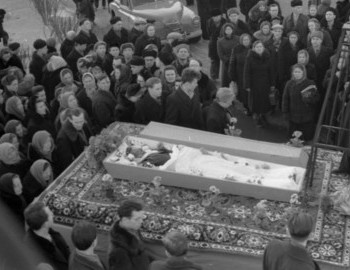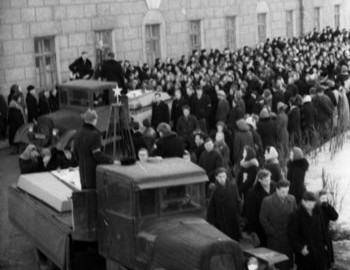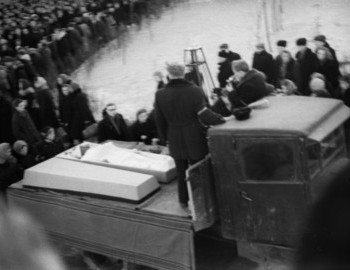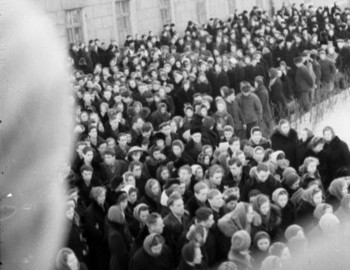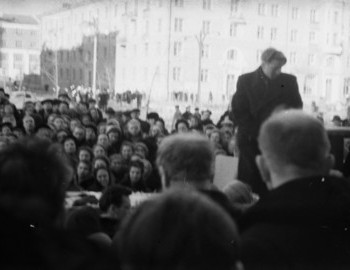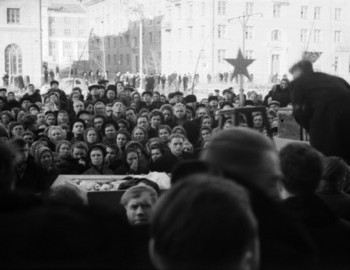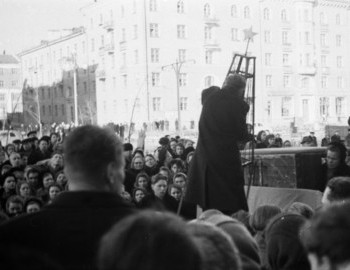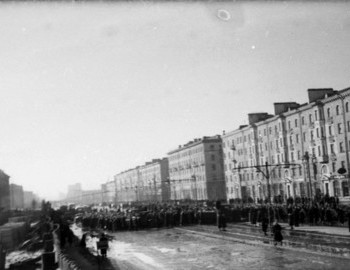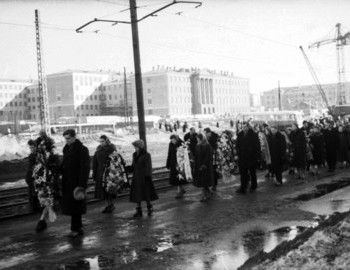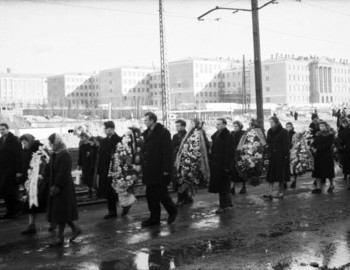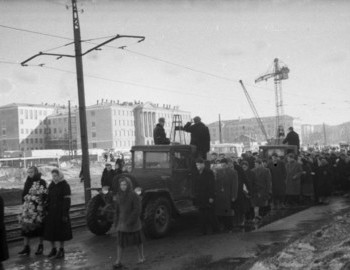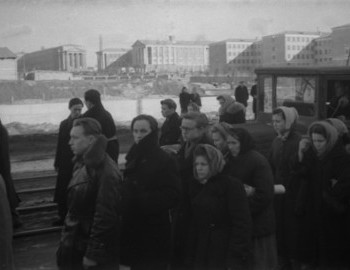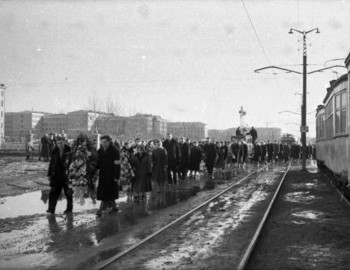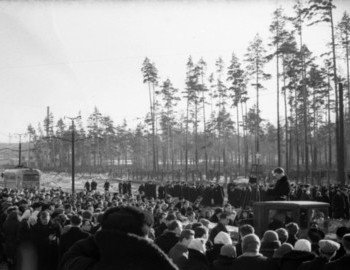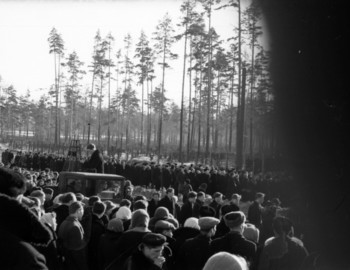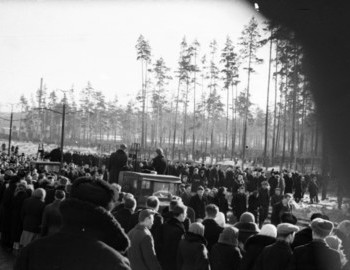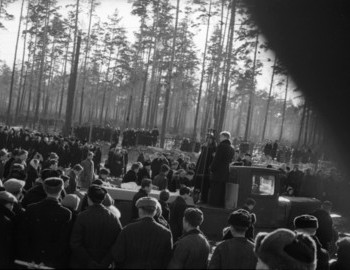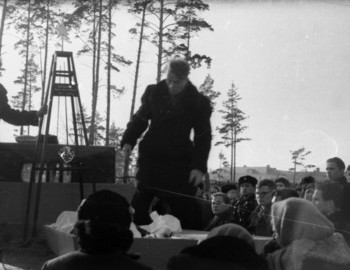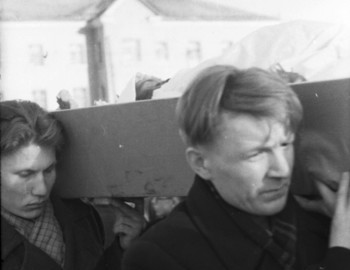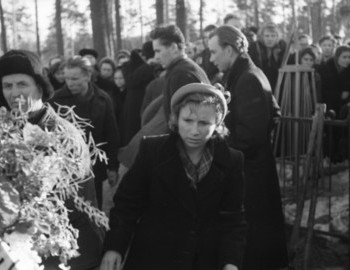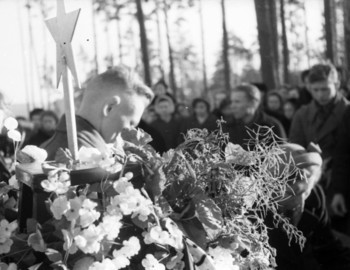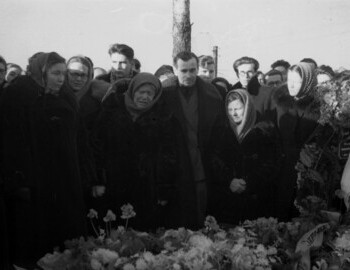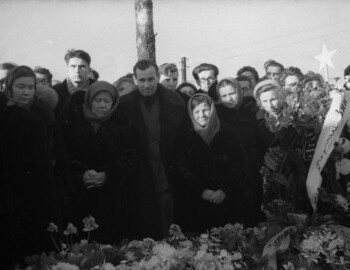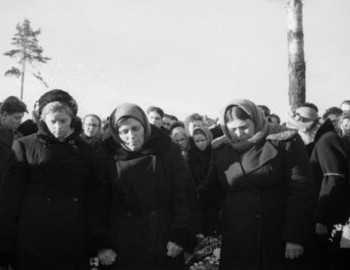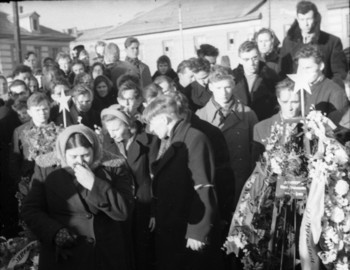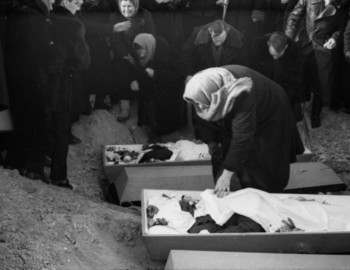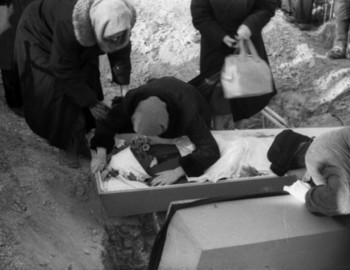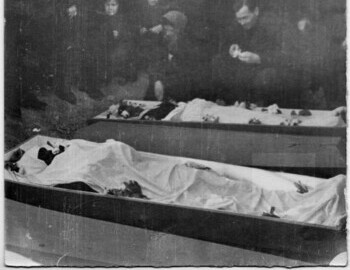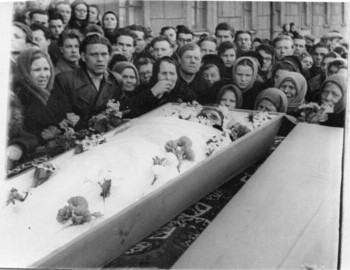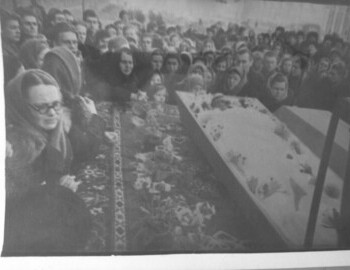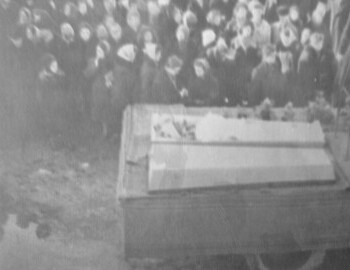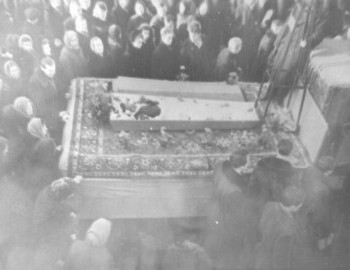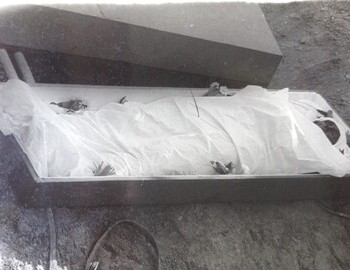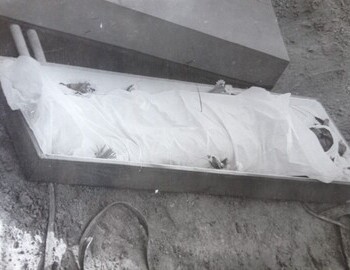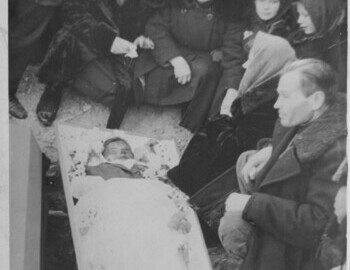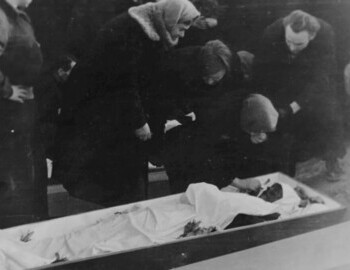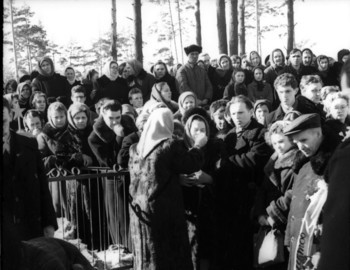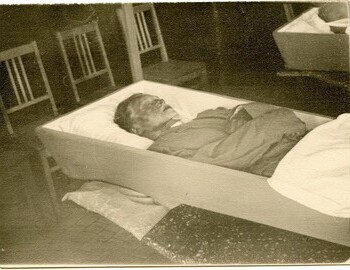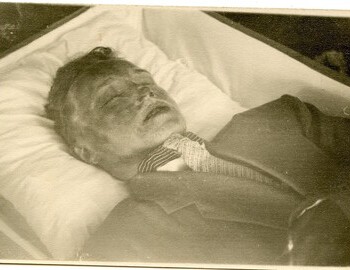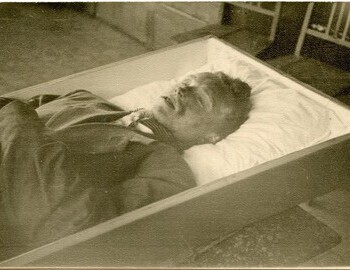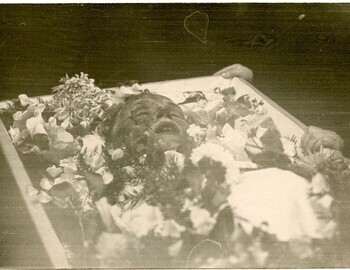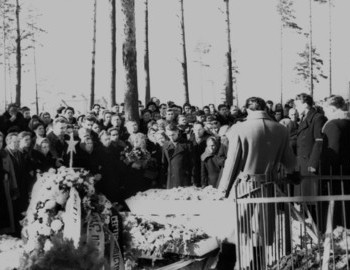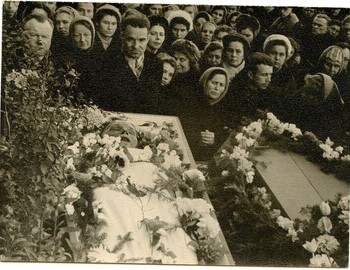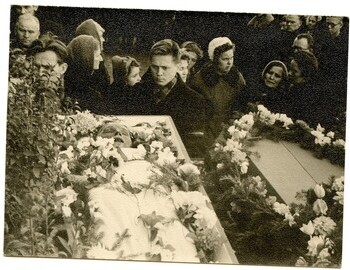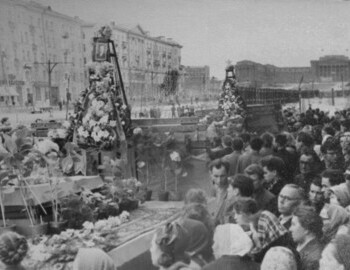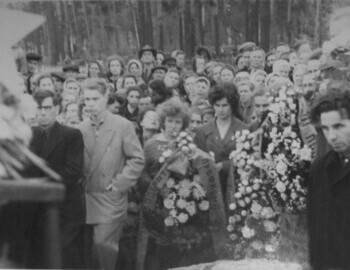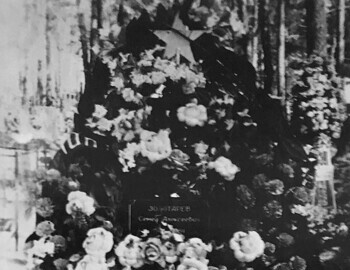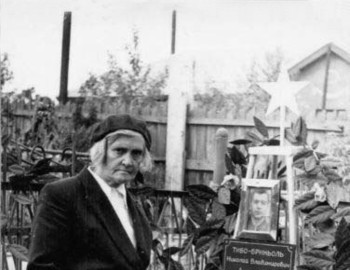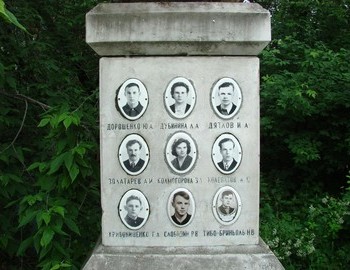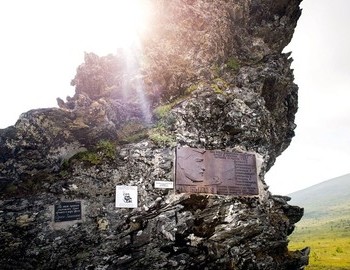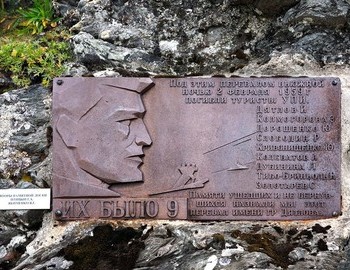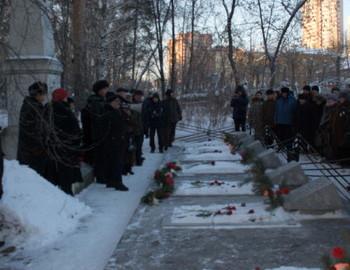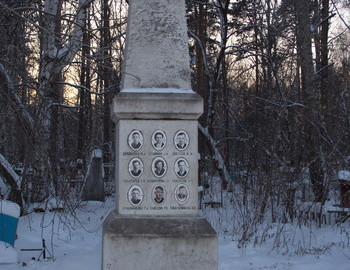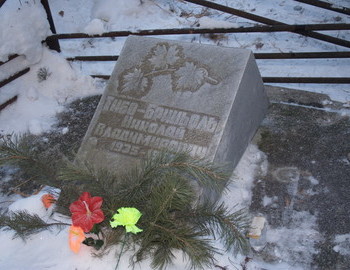
Funerals 1959
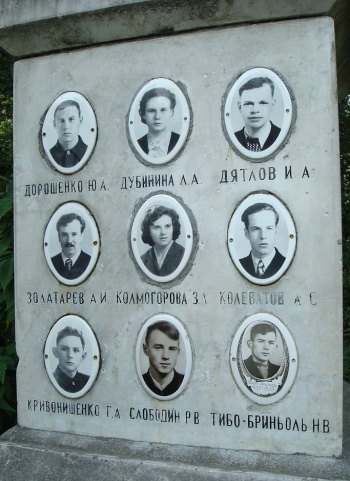
Dyatlov group monument erected in 1962
Mihaylovskoe cemetery, Sverdlovsk
On March 9, 1959, Yuri Doroshenko and Zina Kolmogorova found their last peace in Mihaylovskoe cemetery, and Yuri (Georgiy) Krivonischenko was buried in Ivanovskoe cemetery. On March 10, 1959, Igor Dyatlov and Rustem Slobodin were laid to rest in Mihaylovskoe cemetery.
Yakimenko, student in UPI and participant in the search operation:
"I hung up the announcement of the funerals in the foyer of the main building of the UPI. Half an hour later I was summoned by the Party Committee of the UPI, where the secretary, Kasuhin, reproached me for disturbance and made me remove the flyers. I refused, but someone took them now anyway. The reaction of the secretary of the party committee is incomprehensible, evidently he is afraid of something. March 9 - an update: Today will be buried only four people, and Yuri Krivonischenko, for some reason in another, Ivanovskoe cemetery, although his parents did not object to his son being buried with the others. We hung another announcement about the funerals. It was immediately taken down by someone. We are outraged. Decided everyone to go in their faculty and by course walk around each classroom and inform the students about the hour and place of the funerals."
The authorities surrounded the funerals with lots of fog and omissions, which greatly overshadowed the already unpleasant event. At first the CPSU tried to persuade the parents of the dead to bury their children in Ivdel quickly and quietly, and the relatives members of the party were reminded of the "party conscience" and unequivocally threatened with reprimand for their obstinacy to bring their dead to Sverdlovks. When it became clear that all attempts to obtain consent to the funeral in Ivdel did not yield the desired result, the party retreated and allowed funerals in Sverdlovsk. However, the commies did not manage to gain full control on how the funerals would be organized. Two flyers manage to escape the censorship, notifying about the place and time of the civil funeral. Obscuring the funerals detail was done, apparently, in order to limit the number of people who came to attend. Nevertheless, on March 9, 1959, a crowd of thousands gathered. When the procession reached Mihaylovskoe cemetery, the funeral procession was not let in through the main gate, but from the adjacent street, for which it was necessary to disassemble the fence. This is what the boorish attitude of the authorities towards the people came down to.
The fact that the Soviet government has behaved with people so shamelessly and disrespectfully should not come as a surprised. The Soviet Union did not sink ships, aircraft did not fall and rockets did not explode, and only labor achievements heroism were proclaimed. Any talk about catastrophes, social unrest and mass deaths was regarded by the authorities as "ideological diversion" and was stopped as quickly and harshly as possible. The authorities were pathologically afraid of any negative information that could at least indirectly cast a shadow on the Soviet government as the best in the world. Hence the irrational fear of saying or letting the superfluous, which determined the logic of many actions of the Communist Party and Soviet leadership at all levels of the bureaucratic hierarchy in the USSR. The death of Dyatlov group, it seems, in no way could discredit the CPSU and the Soviet government, however, the authorities themselves did not consider it and tried to organize the funeral processions in March 1959 so that they are less talked about in the city. It turned out to be not the smartest move, since there were still a lot of talking about the dead hikers in Sverdlovsk, but besides that, it amounted resentment against the unfair attitude of the authorities to the tragedy.
Despite, or possibly because of the authorities’ strenuous effort to limit interest in the funerals, the number of mourners was enormous. The plan was for the procession to stop for a moment at the university where they had all studied. The police, of course, did not allow this, and the whole crowd was turned away and forced to follow an alternative route. Yuri Kuntsevitch, the head of the Dyatlov Foundation in Yekaterinburg, said: “At that time I lived next to the cemetery, and was 12 years old, so I was really interested. I tried to push through the crowd to see everything, but it was impossible. I was amazed by some of the people in the crowd. They were wearing trilby style felt hats and had jodhpurs or motorcycle riding pants. They were supervising the procession with their faces blank, expressing nothing. I was standing on a pile of earth at the graveside and I was about eight meters from the bodies. Their skin had a somewhat brick color, and I saw some of the students helping to lower the coffins to the graves. It was said they were there despite being forbidden to leave their classes to attend."
Next to the 4 graves of the Dyatlov group at the Mihaylovskoe cemetery, another student of the Sverdlovsk Polytech, named Victor Nikitin, who died of pneumonia, was soon buried. He studied at the first year of the institute, did not take interest in tourism, and most likely did not even know the members of the Dyatlov group. Nikitin was a country boy from a very poor family; his family could not pay for the transportation of the body to his hometown, and the weather was bad. It was decided to buried in Sverdlovsk. To the history of Dyatlov The death of Victor Nikitin is not related to the Dyatlov Pass history. That didn’t prevent the conspiracy to involve his death, as anything else that touches Dyatlov Pass incident. The fact that he was buried next to the 4 graves of Dyatlov group members, and Krivonischenko being buried in another cemetery made him a secret agent. We keep saying that the Krivonischenko’s burial at Ivanovskoe cemetery has nothing to do with his parents, but what is really certain in this case? The fact that such a request is not documented on the net doesn’t necessarily mean that it doesn’t exist. The government’s desire to disperse the interest towards the event may also yield to a consent or even encouragement such move.
March 9, 1959
The film with 35 frames belongs to Valentin Gerasimovich Yakimenko, the 36th photo is from Evgeniy Grigorievich Zinovyev. Both are UPI students, members of the search operation. The last 8 photos are given to Dyatlov fondation from Tamara Aleekseevna Zaprudina (Kolmogorova), Zina's sister.
Victor Bogomolov (whois) recalls: "In the foyer of the tenth student dormitory on Lenin Street, the coffins with the bodies of Igor Dyatlov, Zina Kolmogorova, Yuri Doroshenko and Rustik Slobodin are displayed on stools in red garb. The lids of the coffins are open, and all those saying goodbye, going around in a circle, have the opportunity to see with their own eyes the faded, brownish-tinted and bruised faces of our silent friends. The parents, relatives and friends of the deceased are leaning over them, inconsolable, with tears in their eyes. Here Zina Kolmogorova's relatives saw us, who had recently visited their village after the December expedition and sang cheerful and lyrical songs together with Igor and Zina, and, of course, a new surge of sobbing. It is difficult to bear it, tears are clouding our eyes.
The funeral procession lines up on Lenin Street and moves in a column to the Polytechnic Institute so that the guys leaving us can say goodbye to the academic buildings of their beloved "alma mater". But even here the students are not allowed to say goodbye to the guys in a dignified manner. A police officer standing at the crossroads directs the column from Lenin Street to Kuzbasskaya Street, now Gagarin Street. The procession moves along the corridor designated for it to the dismantled cemetery fence at the turn of Kuzbasskaya St. Graves have already been dug there. The members of the Dyatlov group set off on their final journey in the caring hands of their friends."
001: The photo is in the family archive of Tamara Zaprudina (Kolmogorova), Zina's sister. Zina Kolmogorova's parents, Varvara Vasilyevna and Alexey Ivanovich Kolmogorov, follow the car in the vcenter. On the left (outside the frame) is UPI dormitory №10 on 66 Lenin Ave.
002: Cars leave from the main entrance of UPI dormitory №10 on 66 Lenin Ave along the sidewalk.
(Yakimenko took these photos from the fence of a building under construction next to UPI dormitory №10)
006: The photo was taken from the main entrance of UPI dormitory №10 on Lenin Avenue 66. In the frame are buildings №97 on the left and 99.
008-009: Lenin Avenue. On the left is the construction ofbuilding №70 and UPI dormitory №10, on the right is building №99.
010: The intersection of Kuzbasskaya St, now Gagarin St, with Lenin Avenue. You can see the house at 28 Mira St. The building at Gagarin 33 is under construction.
016: The intersection of Kuzbasskaya St, now Gagarin St, with Pervomayskaya St. On the left is the Suvorov Military School (Pervomayskaya 88).
017-020: The intersection of Kuzbasskaya St, now Gagarin St, with Akademicheskaya St. Yakimenko took the photo from the fire escape of the building opposite the cemetery in the direction of the Mikhailovskoe Cemetery.
027: In the center is Zina Kolmogorova's father - Aleksey Ivanovich Kolmogorov. From Tamara Zaprudina (Kolmogorova) family archive.
028: Zina Kolmogorova's parents - Alexey Ivanovich Kolmogorov and Varvara Vasilyevna Kolmogorova
030: Farewell to Yuri Doroshenko, Iya Vitalievna Golendukhina (head of the school hiking club), mother Nadezhda Artemovna and aunt
031: According to Shestopalov - in the photograph are students from the study group of Yuri Doroshenko: Kostrulin, Seyatelev, Misolin, etc.
036: From Tamara Zaprudina (Kolmogorova) family archive
037: From Tamara Zaprudina (Kolmogorova) family archive
038: Zinovyev archive
039 - 043: From Tamara Zaprudina (Kolmogorova) family archive
044: From Irina Rashevskaya's archive, Yuri Doroshenko's sister
March 10, 1959
Dyatlov and Slobodin are buried in Mihaylovskoe cemetery.
The photos from Rustem Slobodin's funeral were aired for first time on March 7, 2022, in History Channel show "History's Greatest Mysteries" episode "The Dyatlov Pass Incident" and provided by Lyudmila Morgunova, Rustem Slobodin's sister.
Witness testimony of Rimma Kolevatova given on April 14 (Case files pages 270-272). This is before the body of her brother was found.
"I was present at all the funerals of the group. Why were their faces and hands all so dark brown? How can we explain the fact that the four of them who were beside the fire, they were obviously alive, why didn’t they try to return to the tent? If they were considerably better dressed, as far as I can see from clothes missing from the tent … if it was a natural disaster, then for sure, after being warmed by the fire, then the guys would have crawled back to the tent. The whole group wouldn’t have perished from an Arctic storm!"
Recollection of relatives and eyewitnesses at the funeral, given almost fifty years after the tragedy, mention the dark orange color of the skin, reminiscent of the color of bricks. Though unusual, nothing of this was recorded in the official records of the autopsies. At that time, all photography was black and white, so there are no color pictures of the dead. Some say that only the exposed skin was darker in color, that the skin under their clothes what could be seen (it was Zina family member who witnessed this), was not so unnaturally colored. Here is a thought - what if this orange tinge was a bad mortician job?
May 11-12, 1959
On May 11 Lyudmila Dubinina and Aleksander Kolevatov were buried in Mihaylovskoe cemetery, in a plot designated to UPI. Semyon Zolotaryov, since he was not a UPI contingent, was buried in Ivanovskoe cemetery where Yuri Krivonischenko was laid to rest on March 9.
Nikolay Thibeaux Brignolle was buried on May 12 at the Sverdlovsk Mihaylovskoe cemetery, next to Dubinina and Kolevatov.
All of them were buried in closed coffins. The UPI students helped unload the coffins at the Koltsovo airport and transport them to the morgue.
Zinovyev would later recall that the victims’ parents and relatives were summoned to the morgue for identification. In the process, only part of the coverlet was opened. Dubinina’s father pulled the coverlet off his daughter’s body and fainted. The identification procedure was interrupted. Until the last moment, Aleksander Kolevatov’s mother had not been informed of her son’s death; after his funeral, her legs were paralyzed. The staff members of the Sverdlovsk city committee for physical culture and sports took part in Zolotaryov’s funeral.
The investigation may have believed that the discovered injuries resulted from the impact of a hurricane. There could also been other reasons not to make public the conclusions of the forensic examination. However, the nature of the injuries suffered by Dubinina, Zolotaryov, and Thibeaux-Brignolle, would not become public knowledge until 30 or 40 years later. Previously, the relatives and friends believed that the a cause of death for everyone was hypothermia, and the impact of low temperature had been listed as cause of death in Zolotaryov’s death certificate, issued by the branch of civil status registration office of the Kirov region of Sverdlovsk on May 12, 1959.
Semyon Zolotaryov's funeral was a few days after May 12. It was delayed so his mother could attend. She had to travel from Krasnodar to Sverdlovsk. Zolotaryov had no relatives or friends in Sverdlovsk, and it was Sogrin who identified his belongings. Before joining Dyatlov group Zolotaryov enlisted in Sogrin's group for a trek to Subpolar Urals that would have lasted 25 days. Zolotaryov needed the title Master of Sports which would have reflected his pay and this trek could have given him the qualification. Sogrin describes him as a very open, outgoing, polite, with good communication skills which is expected for a guide. Semyon explained to Sogrin that he found a shorter trek (15 days) and that Igor Dyatlov accepted him n the group. Semyon apologized for the situation and explained that he has family reason - he wanted to take his mom to Caucasus before the begging of the hiking season when he will be busy.
Zolotaryov’s mother came from Krasnodar to Sverdlovsk to collect his belongings in April, as she had been told to, before her son was found. It’s known she was not in Sverdlovsk in May when the bodies arrived. It’s likely that the authorities guessed the body was that of Zolotaryov by the process of elimination. I have to mention that all the known photographs of Zolotaryov that can be used for superimposition are since 1943 i.e. after the war. Recent exhumation of Zolotaryov's body on 12 April 2018 was preceded by 1 year effort to obtain a permit since there was no record of Semyon Zolotaryov being ever buried in Ivanovskoe cemetery, or anywhere else in Sverdlovsk. So it is hard to say when exactly was his funeral, but witnesses remember that it was a few days after May 12.
This time no one called Yudin to identify the bodies. The secrecy grew tremendously. Yuri Yudin, according to his words, was told 40 years later about the terrible internal injuries some of his friends had. There is a controversy about the non-disclosure. Even if there was a non-disclosure why nobody say anything earlier. On the other hand, there is undercurrent that KGB was warning that bad things are going to happen to people that try.
- Korotaev in a interview says that he and everybody present on the pass had to sign a non-disclosure for 25 years. But the fact is that he was never on the pass. He gave a lot of information that can not be verified.
Investigator Vladimir Korotaev — non-disclosure
- Gushtin book "The price of a Govsecret - 9 lives"
The last 4 bodies found in May were buried in closed coffins, unlike the ones found in February, which were buried in open coffins as is the usual practice in Russia to this day, except for military deaths. Many years later, in the 1990s, Lev Ivanov, the official investigator for the case, apologized for preventing the parents from dealing with their loved ones in a proper way, not even being allowed to see the faces of their children. But the reasons for his decision are not just based in secrecy. In an interview given to a Kazakh newspaper in the 1990s, after his retirement, Lev Ivanov said he had made one exception for Aleksander Nikolaevich, the father of Lyudmila Dubinina. While she was in the coffin in the morgue, he let her father enter, and permitted someone to open the lid so that he could see her. When he saw his daughter’s corpse, he fainted.
Witness testimony of Aleksander Dubinin given on April 14 (Case files pages 284-287). This is before the body of his daughter was found.
"Till the day I still can believe that this could happened in the Soviet Union, that in this large industrial and cultural center of the country, could exist such a criminal disregard for preserving the lives of a whole group of people. ...Those heartless leaders were never concerned that eight days after the planned return date at Vizhay, there was no contact, yet nobody did anything and search was rescue operations started on the 21 February."
1962-1963
In 1962, next to their graves in Mihaylovskoe Cemetery, a monument was erected with pictures of all nine members of the group. In August 1963, on that pass on Kholat Syakhl mountain, a group led by Valentin Yakimienko set a memorial plaque (see photos) saying: "In memory of those who left and did not return, we name this pass after the Dyatlov group"
«Их было 9. Под этим перевалом вьюжной ночью 2 февраля 1959 г. погибли туристы УПИ Дятлов И., Колмогорова 3., Дорошенко Ю., Слободин Р., Кривонищенко Ю., Колеватов А., Дубинина Л., Тибо-Бриньоль Н., Золотарев С. Памяти ушедших и не вернувшихся назвали мы этот перевал имени группы Дятлова»
The Pass has been called Dyatlov Pass ever since.
2009
Mihaylovskoe cemetery on the 50th anniversary of Dyatlov group tragedy.

